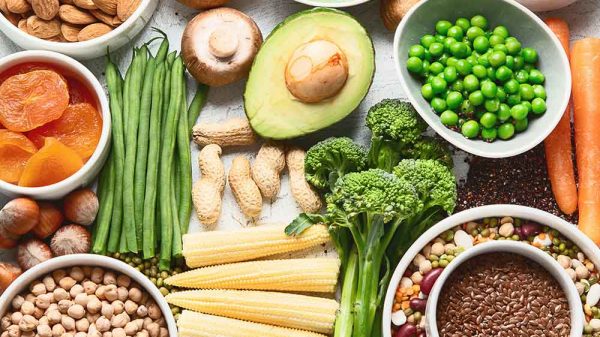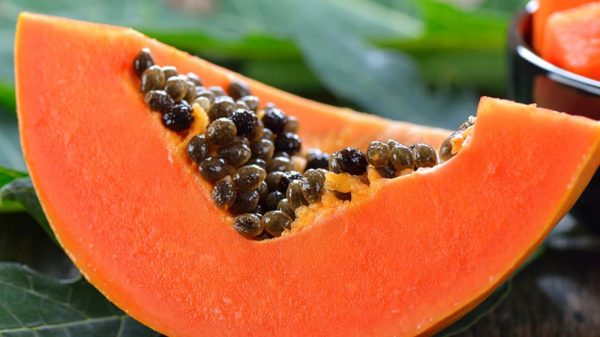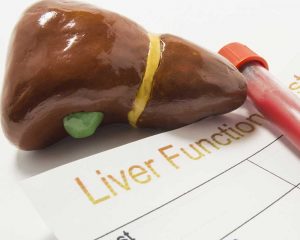The kiwi, also known as the Chinese gooseberry, is a popular fruit that is covered with characteristically fuzzy skin. You probably recognize kiwi as the tasty fruit with vibrant green flesh, a white center, and black seeds that often makes its way into summer salads. But did you know that kiwi is a health-promoting fruit that may even play a role in reversing fatty liver disease? Below we’ve compiled the top benefits of kiwi fruit, and why you should also be eating kiwi skin.
1. Kiwi Skin Triples Fiber Content
Kiwi fruits contain both soluble and insoluble fiber. Soluble dietary fiber dissolves in water and can be digested, while insoluble fiber passes through the digestive tract with very little processing. The dietary fiber you’re getting from kiwi is nearly three times higher when you eat the entire fruit, including the skin of a kiwi. Plus, the rich fiber content provided by the skin of a kiwi fruit aids with weight loss and contributes to lower blood pressure.
2. Vitamin E
Vitamin E is a nutrient that exhibits antioxidant activity and enhances skin health and is abundant in kiwi fruit. Interestingly, vitamin E may play also a role in reversing fatty liver disease by attenuating inflammation in liver cells.
3. Vitamin C
Vitamin C is vital for supporting healthy immune function, preventing colds, and healing from illnesses. Plus, vitamin C works as an antioxidant to help reverse inflammation associated with fatty liver disease. Consuming the skin of kiwi with the kiwi fruit helps lock in more of the naturally occurring vitamin C, for enhanced benefit.
4. Protein-Digesting Enzymes
Kiwi fruit contains actinidin, a proteolytic enzyme that expedites protein digestion and enhances protein absorption. (1)
Research conducted on pigs at the Riddet Institute at Massey University in New Zealand showed that eating kiwi fruit with beef protein facilitated protein digestion and the absorption of individual amino acids. (2)
The proteolytic enzyme in kiwi may have implications for human digestion and absorption of meat. Before a meal containing high amounts of animal protein, try adding fresh kiwis to your meal as an appetizer.
5. Antioxidants
Antioxidants come in the form of micronutrients like vitamins, minerals, and polyphenols. Fresh fruits, like kiwi, are filled of antioxidants that help your body fight against tissue damage caused by inflammatory agents such as pollutants and toxins. Specifically, kiwis can help reverse oxidative damage found in fatty liver disease.
6. Low in Calories
One whole kiwi fruit only contains about 45 to 50 calories, depending on its size. The skin of the kiwi contributes very few calories. You could consume three whole kiwis for just 150 calories!
As with many fruits, kiwi calories take up only a minimal proportion of your calories for the day. So, feel free to eat several kiwis as a nutritious snack.
7. Healthy Source of Energy
Kiwi contains sugars that your body converts into glucose to fuel cellular processes. Plus, the sugar contained within fruits like kiwis do not contribute to fatty liver disease. This is because fruit sugar is paired with fiber that slows the release of sugar into the bloodstream. As a result, your liver can efficiently transform sugar into energy, without having to store excess sugars as fat. In turn, kiwis give you a sustained energy source that can fuel your brain, muscles, and nearly every other cell in your body without an energy crash later.
The slow release of kiwi sugar into the bloodstream is quantified by the glycemic index, which reflects how rapidly dietary sugars enter the blood following consumption. The glycemic index of green kiwis is measured at about 39 while the glycemic index for gold kiwis is approximately 48, which lands both types of kiwis in the low glycemic index range. (1)
For reference, the glycemic index of a doughnut is above 70, meaning it rapidly spikes your blood sugar following ingestion. (3)
So, for a sweet snack that also provides long-lasting energy, choose kiwis instead of a packaged snack high in refined sugars and simple carbohydrates.
8. More Protein Than You Think
Though kiwi is by no means a rich source of protein, it contains more protein than you think. Eating a whole kiwi provides about 0.8 grams of protein. (4)
Eating a couple of kiwis, depending on their size, can provide up to 2 grams of protein. You shouldn’t rely solely on fruits like kiwi as your main source of protein. Fruits don’t contain all essential amino acids that we must consume through our diet in order to fuel all biological processes. However, a couple of extra grams of protein are better than none!
9. They Are Tasty!
The sweet, mild flavor of kiwi fruit makes it an appealing snack on its own or as part of a fruit salad. Keep in mind that eating the whole fruit is more nutritious than throwing the kiwis in a smoothie. Blending the kiwi fruit destroys some of the fiber that aids slow sugar release in the bloodstream.

How to Eat a Kiwi
To harness all of the benefits of kiwi, it’s helpful to know the most convenient ways to eat them!
How to Cut a Kiwi
Before cutting a kiwi, wait until it is ripe. An unripe kiwi is hard and difficult to bite into, with a characteristically sour taste. Allow a kiwi to ripen by leaving it unrefrigerated for a couple of days or so. You can tell if a kiwi is ripe by lightly squeezing it. If the flesh is soft but not mushy when pressed, the kiwi is ripe.
One of the simplest ways to eat a kiwi it to slice it in half, in either direction you like. Then, using a spoon, you can easily eat the fruit by scooping it out with a spoon. Alternatively, you can first peel the kiwi using a simple peeler. Try to peel away only the thin skin so you don’t have to sacrifice any of the fruit. After peeling, cut into round slices and enjoy.
What to Do About Kiwi Skin
For some, the fuzzy, slightly rough skin of kiwi can be a deterrent to eating kiwis. You may be wondering: Can you eat kiwi skin? The answer is yes! Just like kiwi fruit, kiwi skin benefits your body. The skin is filled with extra fiber, folate, and vitamin C while offering very few calories. If the fuzz on the green kiwi skin is bothersome, try eating the skin of the gold kiwi, which is much smoother.
When eating a kiwi with the skin, make sure to thoroughly wash it first to clear away any grime or residual pesticides. Then go ahead and bite into it like an apple! Though kiwi skin isn’t for everyone, eating a whole kiwi is the most convenient way to go if you like the skin. Kiwi fruit often contains tough ends that may be difficult to eat. Simply discard them after you’ve eaten the rest of the fruit.
Conclusion
If you’re looking for a nutritious, low-calorie, snack that affords numerous health benefits and supports your liver, kiwis are an excellent option.
References:
(1) https://www.ncbi.nlm.nih.gov/pmc/articles/PMC6267416/
(2) https://www.ncbi.nlm.nih.gov/pubmed/24252432
(3) https://www.health.harvard.edu/healthbeat/a-good-guide-to-good-carbs-the-glycemic-index
(4) https://fdc.nal.usda.gov/fdc-app.html#/food-details/341571/nutrients























